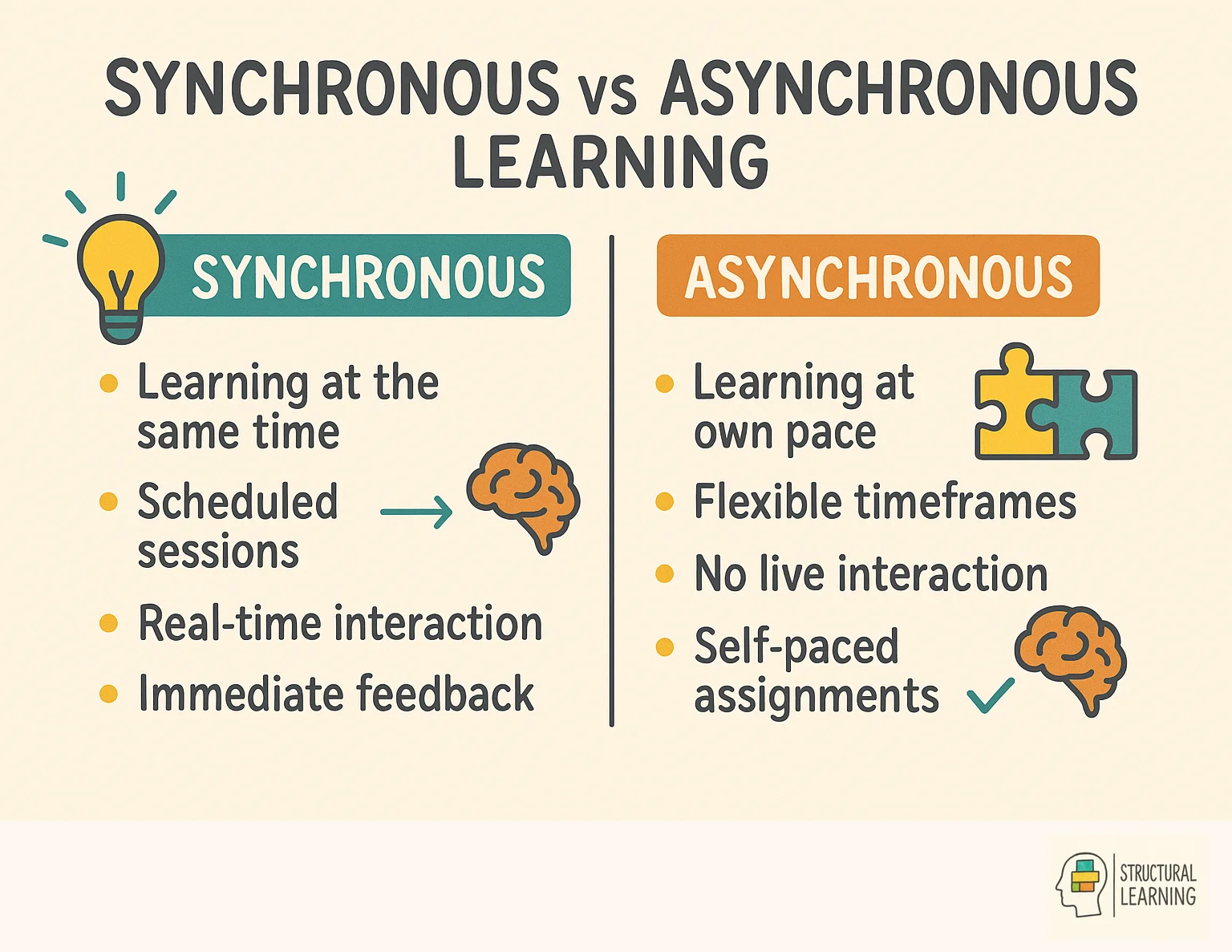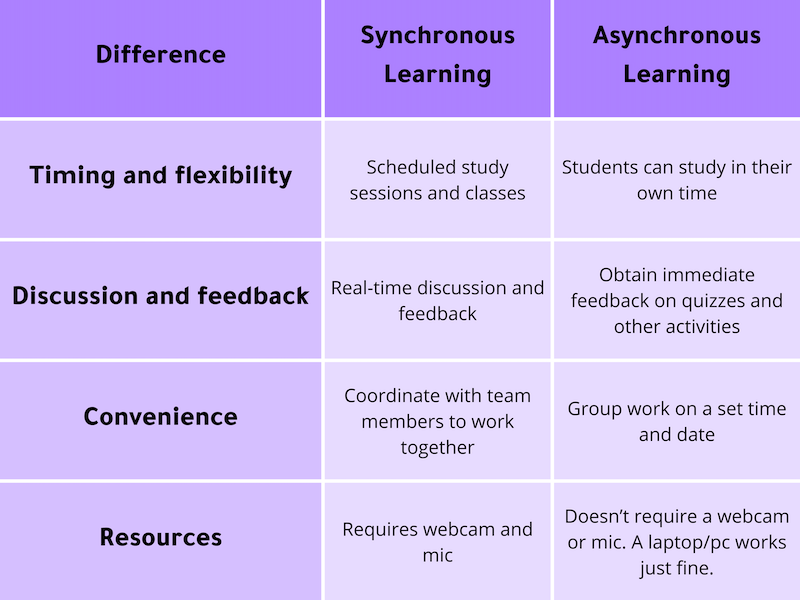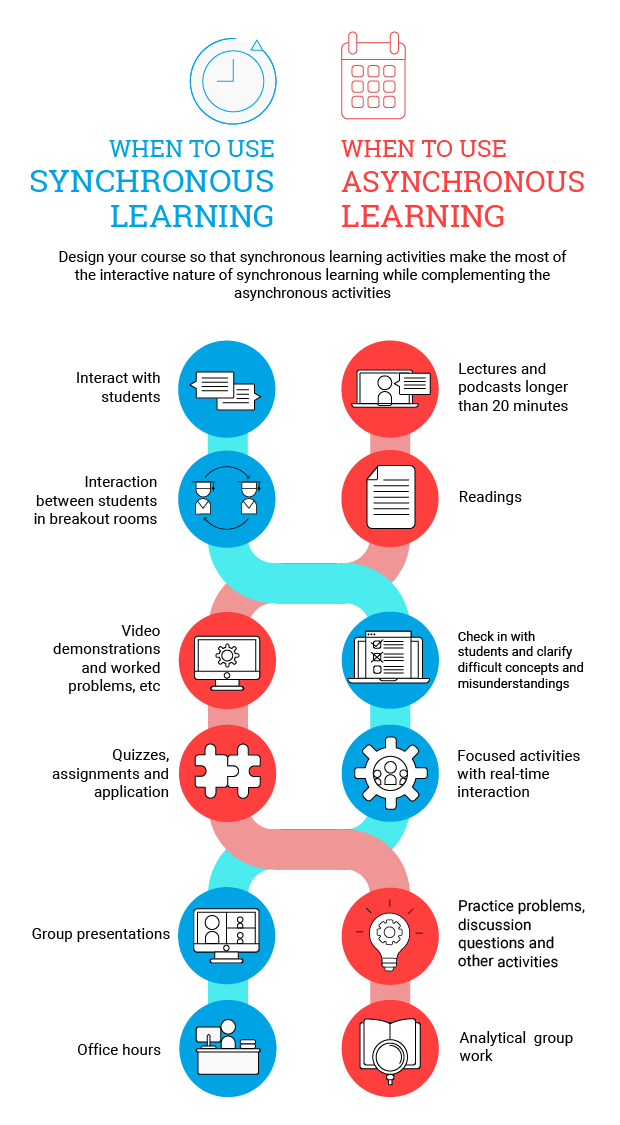Asynchronous Learning
Explore Asynchronous Learning: Understand its benefits, how it works, and get practical strategies for teachers to effectively implement it in their classrooms.


Explore Asynchronous Learning: Understand its benefits, how it works, and get practical strategies for teachers to effectively implement it in their classrooms.
Asynchronous learning lets students access coursework at their own pace and on their own schedule. Unlike live classes, this approach does not require real-time interaction with teachers or classmates. This flexibility makes it ideal for busy learners or those who prefer .
In this learning environment, online platforms deliver course materials, support student discussions, and provide resources like recorded lectures and digital libraries. These platforms can incorporate various teaching strategies to enhance the learning experience. Students can access content anytime from anywhere with an internet connection, though they may miss opportunities for dialogic teaching found in live sessions.

One key benefit is self-paced study. Research by Fabriz, Mendzheritskaya, and Stehle found that students in asynchronous courses reported greater support for their basic psychological needs. This approach lets learners review content at their own speed, similar to a spiral curriculum where concepts are revisited and built upon, creating a more personal learning experience that supports effective tracking progress with appropriate scaffolding support.
Asynchronous learning also removes the need for strict meeting times. Students can balance studies with work or family commitments. This empowers learners to take control of their own learning journey and helps build cultural capital through self-directed study, though it may lack the interactive discussions found in real-time classroom settings.
Consider a working professional pursuing an online degree. With asynchronous learning, they can watch lectures, join discussions, and complete assignments after work or during weekends without changing their work schedule.
These two approaches to remote learning have different strengths.
Synchronous learning requires students to attend virtual classes at set times and follow a fixed schedule. This format offers immediate feedback, live discussions, and direct engagement with teachers and classmates. It mirrors the traditional classroom and works well for students who thrive on structure and real-time interaction.
Asynchronous learning gives students freedom and independence. Learners access materials, lectures, and resources at any time. This suits students with other commitments, letting them create their own study schedule. It also builds as students take charge of their time and progress.
Each approach has its place. In remote settings, combining both creates a complete learning experience that meets different student needs.
This approach offers several clear benefits:

Follow these principles to make asynchronous learning work well:
Clear Communication and Structure: Give students a well-organised course outline and schedule. Make navigation simple. Set clear expectations for assignments and deadlines.
Foster Engagement: Use interactive activities like online discussions and group projects. Create forums where students can connect with classmates and share ideas.
Provide Regular Feedback: Teachers should respond to work promptly and stay available for questions. This personal attention keeps students motivated.
Use Mixed Media: Include videos, audio clips, and interactive elements. Different formats suit different .
Build Community: Online learners can feel isolated. Create chances for social connection through discussions, group work, and peer sharing.

Asynchronous learning works well in many settings.
Online Courses: Students watch pre-recorded lectures, join forum discussions, complete assignments, and work on group projects. All at times that suit them. This helps working professionals who cannot attend fixed class times.
Professional Development: Employees access training materials when it fits their schedule. This works for busy staff and teams spread across different locations.
The benefits include greater engagement and participation, as learners control their experience. Students also build skills by managing their own time and progress.

Several trends are shaping how asynchronous learning develops:
Mobile Learning: With widespread smartphone use, learners access courses on the go. This supports learning anytime, anywhere.
Gamification: Adding game elements like points, badges, and leaderboards makes learning more engaging and fun while still meeting learning goals.
Personalised Pathways: analyse student data to provide custom content and learning paths. Each student progresses at their own pace with support where they need it most.
These advances give learners greater flexibility, engagement, and personal attention.

Here are seven steps to move your teaching online:

These studies highlight the roles of instructors, benefits of flexible teaching, and the importance of community in online learning.
Asynchronous learning lets students access coursework at their own pace and on their own schedule. Unlike live classes, this approach does not require real-time interaction with teachers or classmates. This flexibility makes it ideal for busy learners or those who prefer .
In this learning environment, online platforms deliver course materials, support student discussions, and provide resources like recorded lectures and digital libraries. These platforms can incorporate various teaching strategies to enhance the learning experience. Students can access content anytime from anywhere with an internet connection, though they may miss opportunities for dialogic teaching found in live sessions.

One key benefit is self-paced study. Research by Fabriz, Mendzheritskaya, and Stehle found that students in asynchronous courses reported greater support for their basic psychological needs. This approach lets learners review content at their own speed, similar to a spiral curriculum where concepts are revisited and built upon, creating a more personal learning experience that supports effective tracking progress with appropriate scaffolding support.
Asynchronous learning also removes the need for strict meeting times. Students can balance studies with work or family commitments. This empowers learners to take control of their own learning journey and helps build cultural capital through self-directed study, though it may lack the interactive discussions found in real-time classroom settings.
Consider a working professional pursuing an online degree. With asynchronous learning, they can watch lectures, join discussions, and complete assignments after work or during weekends without changing their work schedule.
These two approaches to remote learning have different strengths.
Synchronous learning requires students to attend virtual classes at set times and follow a fixed schedule. This format offers immediate feedback, live discussions, and direct engagement with teachers and classmates. It mirrors the traditional classroom and works well for students who thrive on structure and real-time interaction.
Asynchronous learning gives students freedom and independence. Learners access materials, lectures, and resources at any time. This suits students with other commitments, letting them create their own study schedule. It also builds as students take charge of their time and progress.
Each approach has its place. In remote settings, combining both creates a complete learning experience that meets different student needs.
This approach offers several clear benefits:

Follow these principles to make asynchronous learning work well:
Clear Communication and Structure: Give students a well-organised course outline and schedule. Make navigation simple. Set clear expectations for assignments and deadlines.
Foster Engagement: Use interactive activities like online discussions and group projects. Create forums where students can connect with classmates and share ideas.
Provide Regular Feedback: Teachers should respond to work promptly and stay available for questions. This personal attention keeps students motivated.
Use Mixed Media: Include videos, audio clips, and interactive elements. Different formats suit different .
Build Community: Online learners can feel isolated. Create chances for social connection through discussions, group work, and peer sharing.

Asynchronous learning works well in many settings.
Online Courses: Students watch pre-recorded lectures, join forum discussions, complete assignments, and work on group projects. All at times that suit them. This helps working professionals who cannot attend fixed class times.
Professional Development: Employees access training materials when it fits their schedule. This works for busy staff and teams spread across different locations.
The benefits include greater engagement and participation, as learners control their experience. Students also build skills by managing their own time and progress.

Several trends are shaping how asynchronous learning develops:
Mobile Learning: With widespread smartphone use, learners access courses on the go. This supports learning anytime, anywhere.
Gamification: Adding game elements like points, badges, and leaderboards makes learning more engaging and fun while still meeting learning goals.
Personalised Pathways: analyse student data to provide custom content and learning paths. Each student progresses at their own pace with support where they need it most.
These advances give learners greater flexibility, engagement, and personal attention.

Here are seven steps to move your teaching online:

These studies highlight the roles of instructors, benefits of flexible teaching, and the importance of community in online learning.